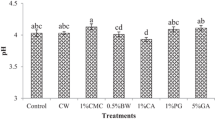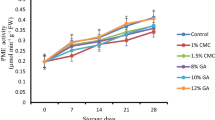Abstract
Psidium guajava L. var. ‘Lalit’ is a perishable fruit with delicate skin which is prone to damage. The objective of this study was to determine the effect of edible coating made up of hydroxypropyl methyl cellulose and palm oil on ripening of guava. Coating solution was applied over fruits and coated fruits were stored at 24 ± 1 °C and 65 ± 5%RH. Changes in fruit colour, texture softening, respiration rate, weight loss, ascorbic acid content, soluble solids, titrable acidity, chlorophyll content, total reducing sugars, total phenolic content were studied during post-harvest ripening. Fruits coated with 1 % of hydroxypropyl methyl cellulose and 0.3 % of palm oil showed significant delay in weight loss, fruit firmness as well as colour change (p < 0.05). Coating delayed the enzyme activities of peroxidase and polyphenol oxidase of the fruit. Results suggest that overall quality of coated fruit was maintained by edible coating formulation extending the shelf life of fruit up to 12 days with appreciable retention of all quality parameters tested.




Similar content being viewed by others
References
Ali A, Maqbool M, Ramachandran S, Alderson PG (2010) Gum Arabic as a novel edible coating for enhancing shelf-life and improving postharvest quality of tomato (Solanum lycopersicum L.) fruit. Postharvest Biol Technol 58:42–47
Andrews PK, Fahy DA, Foyer CH (2004) Relationship between fruit exocarp antioxidants in the tomato (Lycopersicon esculentum) high pigment -1 mutant during development. Physiol Plant 120:519–528
Antoniali SA, Paulo ML, Anna Maria M, Rogerio TF, Juliana S (2007) Physicochemical characterization of ‘zarco hs’yellow bell pepper for different ripeness stages. J Sci Food Agric 64:19–22
Ashwell G (1957) In: Colowick SJ, Kaplan NO (eds) Methods in enzymology, vol 3. Academic Press, New York, p. 75
Aydin N, Kadioglu A (2001) Changes in the chemical composition, polyphenol oxidase and peroxidase activities during development and ripening of Medlar fruits (Mespilus germanica L.). Bulg J Plant Physiol 27:85–92
Bajaj KL, Kaur G (1981) Spectrophotometric determination of L-ascorbic acid in vegetables and fruits. Analyst 106(1258):117–120
Baldwin EA (1994) Edible coatings for fresh fruits and vegetables: past, present, and future. In: Edible coatings and films to improve food quality. Technomic Publ. Co. Inc, Lancaster, pp. 25–64
Bashir HA, Abu-Goukh AA (2003) Compositional changes during guava fruit ripening. Food Chem 80:557–563
Che Man YB, Liu JL, Jamilah B, Rahman RA (1999) Quality changes of RBD palm olein, soybean oil and their blends during deep-fat frying. J Food Lipids 6(3):181–193
Chitravathi K, Chauhan OP, Raju PS (2014) Postharvest shelf-life extension of green chillies (Capsicum annuum L.) using shellac-based edible surface coatings. Postharvest Biol Technol 92:146–148
Ciou J, Lin H, Chiang P, Wang C, Charles A (2011) The role of polyphenol oxidase and peroxidase in the browning of water caltrop pericarp during heat treatment. Food Chem 127:523–527
El-Bulk RE, Babiker EFE, Tinay AHE (1997) Changes in chemical composition of guava fruits during development and ripening. Food Chem 59:395–399
El Ghaouth A, Arul J, Ponnamaplam R, Boulet M (1991) Use of chitosan coating to reduce water loss and maintain quality of cucumber and bell pepper fruits. J Food Process Preserv 15:359–368
Gawlikdziki U, Szymanowska U, Baraniak B (2007) Characterization of polyphenol oxidase from broccoli (Brassica oleracea var. botrytis italica) florets. Food Chem 105(3):1047–1053
Gontard N, Thibault R, Cuq B, Guilbert S (1996) Influence of relative humidity and film composition on oxygen and carbon dioxide permeabilities of edible films. J Agric Food Chem 44:1064–1069
Gorny JR, Kader AA (1998) Fresh-cut products: maintaining quality and safety, University of California Davis, Workshop September 15–16 (1998), 4:12–14
Greener IK, Fennema O (1989) Barrier properties and surface characteristics of edible, bilayer films. J Food Sci 54:1393–1399
Hagenmaier RD, Shaw PE (1990) Moisture permeability of edible films made with fatty acid and (hydroxypropyl) methyl cellulose. J Agric Food Chem 38:1799–1803
Jain N, Dhawan K, Malhotra S, Singh R (2003) Biochemistry of fruit ripening in guava (Psidium guajava L) compositional and enzymatic changes. Plant Food Hum Nutr 58:309–315
Kong KW, Ismail A (2011) Lycopene content and lipophilic antioxidant capacity of by-products from Psidium guajava fruits produced during puree production industry. Food Bioprod Process 89:53–61
Mahmood T, Anwar F, Abbas M, Boyce MC, Saari N (2012) Compositional variation in sugars and organic acids at different maturity stages in selected small fruits from Pakistan. Int J Mol Sci 13:1380–1392
Maqbool M, Ali A, Ramachandran S, Smith DR, Alderson PG (2010) Control of postharvest anthracnose of banana using a new edible composite coating. Crop Prot 29:1136–1141
Mercado-Silva E, Benito-Bautista P, De los A, García-Velasco M (1998) Fruit development, harvest index and ripening changes of guavas produced in central Mexico. Postharvest Biol Technol 13(2):143–150
Miller GL (1972) Use of DNS reagent for the determination of glucose. Anal Chem 31:426–428
Morillon V, Debeaufort F, Blond G, Capelle M, Voilley A (2002) Factors affecting the moisture permeability of lipid-based edible films: a review. CRC Crit Rev Food Sci 42(1):67–89
Nadeesha MKF, Bamunuarachchi, Edirisinghe EMRKBM, Weerasinghe WMSK (2007) Studies on antioxidant activity of Indian gooseberry and seed. J Sci Univ Kelaniya 3:83–92
Ozden C, Bayindirli L (2002) Effects of combinational use of controlled atmosphere, cold storage and edible coating applications on shelf life and quality attributes of green peppers. Eur Food Res Technol 214:320–326
Pandey SK, Joshua JE, Bisen, Abhay (2010) Influence of gamma-irradiation, growth retardants and coatings on the shelf life of winter guava fruits (Psidium guajava L.). J Food Sci Technol 47(1):124–127
Salunkhe DK, Bolin HR, Reddy NR (1991) Storage, processing, and nutritional quality of fruits and vegetables, 2. CRC Press, Boca Raton
Sapru V, Labuza TP (1994) Dispersed phase concentration effect on water vapor permeability in composite methyl cellulose-stearic acid edible films. J Food Process Preserv 18:359–368
Silva ED, Lourenco EJ, Neves VA (1990) Soluble and bound peroxidase from papaya fruit. Phytochem 29:1051–1056
Soares FD, Pereira T, Marques MM, Monteiro AR (2007) Volatile and non-volatile chemical composition of the white guava fruit (Psidium guajava) at different stages of maturity. Food Chem 100:15–21
Underhill SJR, Critchley C (1995) Cellular localisation of polyphenol oxidase and peroxidase activity in Litchi chinensis Sonn. pericarp. Aust J Plant Physiol 22:627–32
Wang Z, Duan H, Hu C (2009) Modelling the respiration rate of guava (Psidium guajava L) fruit using enzyme kinetics, chemical kinetics and artificial neural network. Eur Food Res Technol 229(3):495–503
Waskar DP, Kheldar RM, Garande VK (2009) Effect of postharvest treatment on the shelf life and quality of pomegranate in evaporative cooling chamber and ambient conditions. J Food Sci Technol 2:114–117
Wolfe K, Wu X, Liu RH (2003) Antioxidant activity of apple peels. J Agric Food Chem 51:609–614
Zhang Z, Pang X, Xuewu D, Ji Z, Jiang Y (2005) Role of peroxidase in anthocyanin degradation in litchi fruit pericarp. Food Chem 90(1):47–52
Acknowledgments
The authors are grateful to University Grants Commission (UGC) for providing the financial support for carrying out this work.
Author information
Authors and Affiliations
Corresponding author
Additional information
Research highlights
Edible coating emulsion of HPMC and palm oil was prepared
Post-harvest changes in Lalit guava fruit studied after coating
1 % of HPMC and 0.3 % of palm oil gave significant delay in ripening
Coated fruit showed lower weight loss & delayed sugar metabolism
Coating delayed activities of peroxidase & polyphenol oxidase of the fruit
Rights and permissions
About this article
Cite this article
Vishwasrao, C., Ananthanarayan, L. Postharvest shelf-life extension of pink guavas (Psidium guajava L.) using HPMC-based edible surface coatings. J Food Sci Technol 53, 1966–1974 (2016). https://doi.org/10.1007/s13197-015-2164-x
Revised:
Accepted:
Published:
Issue Date:
DOI: https://doi.org/10.1007/s13197-015-2164-x




